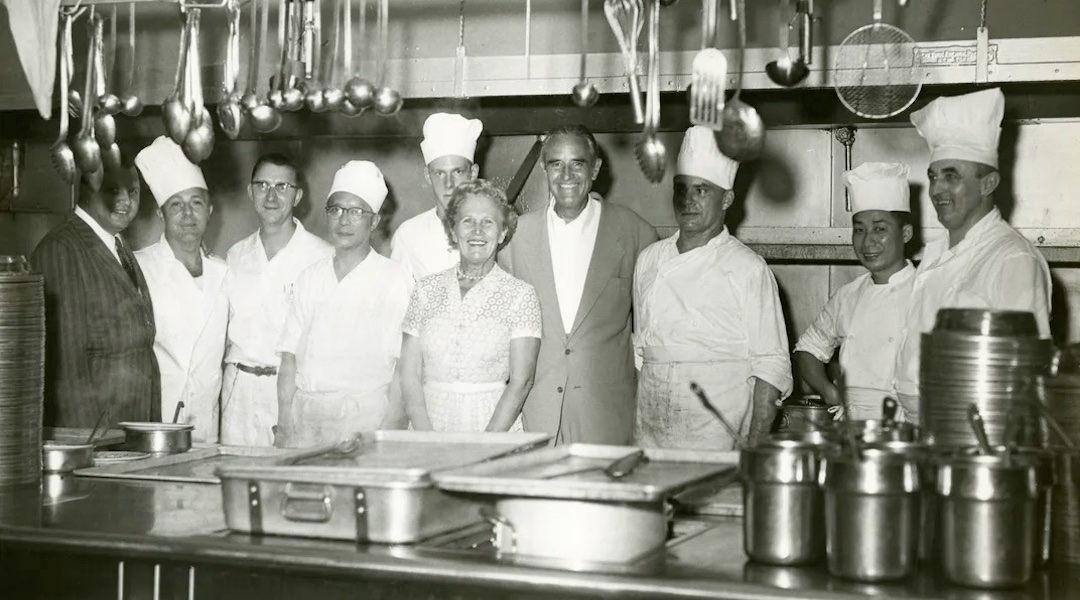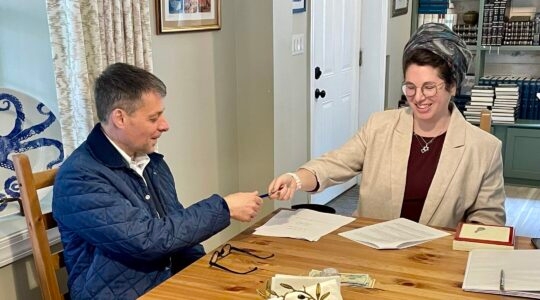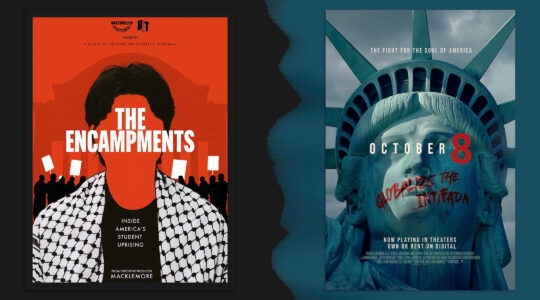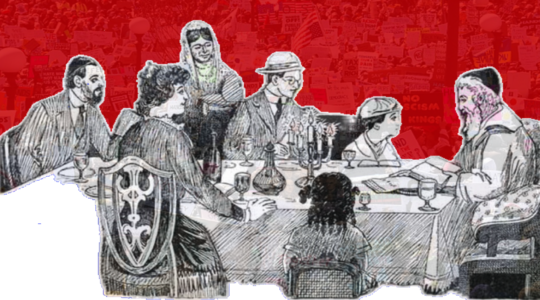“We honeymooned at Kutsher’s in late October 1968,” Barbara Gelman recalled in an oral history for the Borscht Belt Museum. “When we ordered dinner, the waitress enumerated all the desserts, and my new husband simply said ‘yes.’”
Gelman’s comments, on display in a new exhibit at the museum in Ellenville, New York, capture an entire Jewish culture in fewer than 30 words. Kutsher’s resort was one of the best known of the Jewish hotels in the Catskills, the region in upstate New York that flourished as a Jewish getaway from the early 20th century to the 1970s.
And while the Catskills were about many things, they were also about two big things: food and humor. Both were doled out in abundance: heaps of mostly Ashkenazi cuisine, and gobs of entertainment rooted in Yiddish and an urban attitude that learned to let loose in the mountain air.
It’s a combination that’s been blended, if you will, in the exhibit, “And Such Small Portions! Food and Comedy in the Catskills Resort Era.” The exhibit takes its name from a classic joke (more on that later) and its inspiration from the nickname of the region. Its centerpiece is a large sculpture of a bowl of borscht by the artist Robin Schwartzman, which sits in a small gallery surrounded by photomurals of the hotels’ once-grand dining rooms, portraits of comedians like Jerry Lewis and Joan Rivers, and even an image of one of perhaps hundreds of Jewish farming families who helped turn Sullivan and Ulster counties into a vacation destination.
The curators are proud of a recreated 1950s bungalow interior, complete with wood paneling, appliances and period ephemera, rescued by the museum’s archivist, and a recreation of a 1970s Kutsher’s hotel room, done up in a groovy palette of greens and yellows.
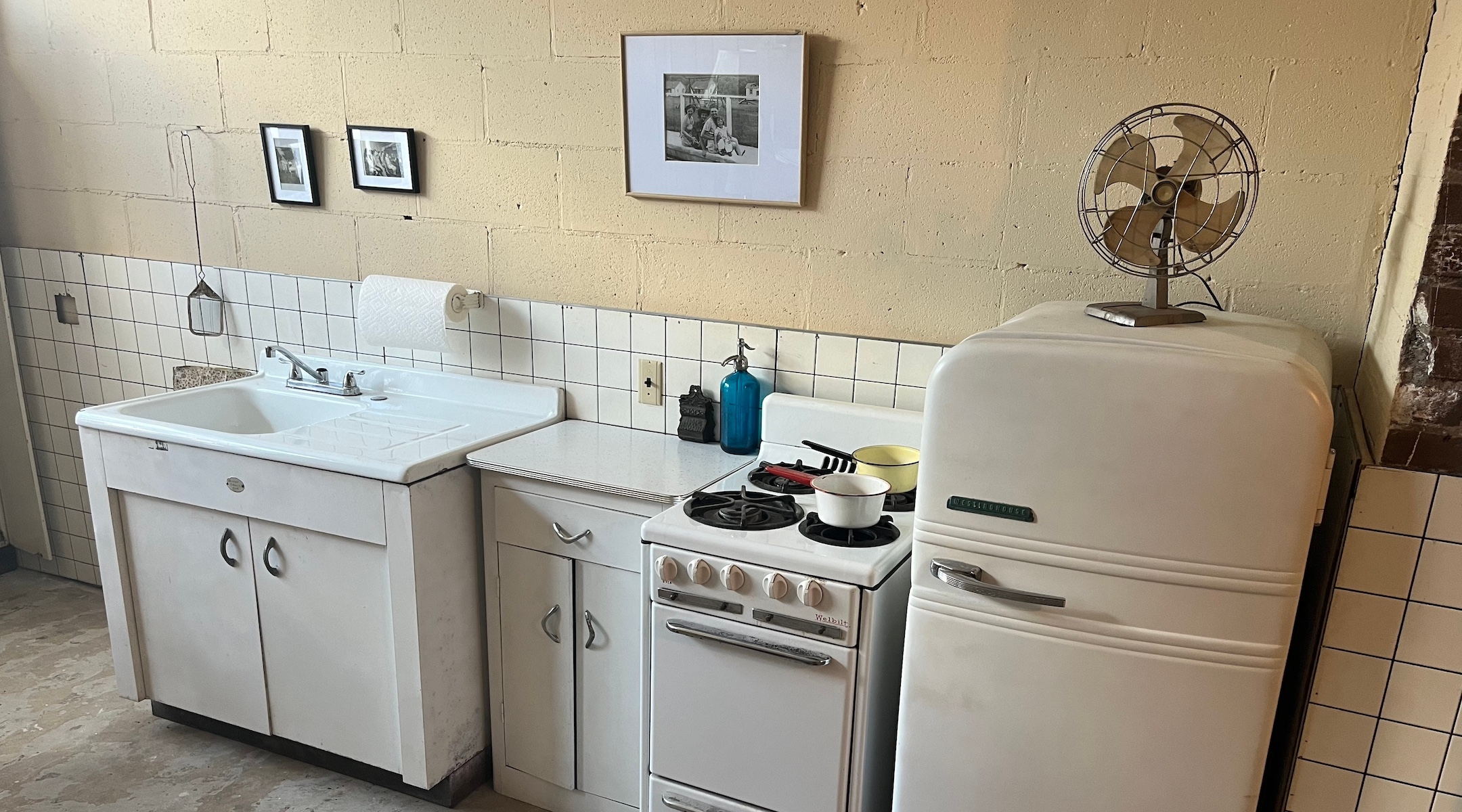
A recreated 1950s bungalow interior is featured in a new exhibit on the food and humor of the Catskills, at the Borscht Belt Museum in Ellenville, New York. Known as a kuchalayn, Yiddish for “cook-alone,” these vacation rentals were the most affordable option for people visiting the Catskills. (Courtesy Borscht Belt Museum)
And menus — plenty of menus. A dinner menu from Kutsher’s might offer 11 “mains,” from Jewish standbys like boiled flanken and potted brisket to more exotic fare like chicken cacciatore and “barbacued [sic] ribs of prime beef, Mandarin.” The appetizers included “stuffed fresh water fish with red beet horse radish,” which sounds suspiciously like gefilte fish. For dessert, there was apple strudel, “sugar bow ties,” fruit sherbet and raspberry jello.
I dimly remember these choices from when my parents would take us to one of the b-list hotels in the waning days of the Borscht Belt, usually in winter. I remember the waiter offering a choice of chicken, beef or fish, and wiseguys like Gelman’s husband saying, “I’ll try them all.” And the waiter would oblige.
That kind overindulgence was both mocked and celebrated in the joke that gives the exhibit its title. The curators — Debra Schmidt Bach, Steven H. Jaffe and Mackensie Griffin — have tracked it down to a 1927 collection of songs and stories called “Bronx Ballads,” although Woody Allen offered a much leaner version in his 1977 film “Annie Hall”: “Two elderly women are at a Catskill mountain resort, and one of ’em says, ‘Boy, the food at this place is really terrible.’ The other one says, ‘Yeah, I know; and such small portions.’”
In one way, that sense of grievance and entitlement was no laughing matter for a generation with living experience of the Depression and the Holocaust, said Jaffe, a historian who has also curated exhibits at the Museum of the City of New York.
“People stocking up on food when they didn’t really actually need it is something we would have called kind of neurotic, right? But it’s a cultural trait or cultural trope,” he told me in a joint Zoom interview with Bach. “Historians like Jonathan Sarna have addressed what was a fear of going hungry — that after you’ve become an ‘alrightnik,’ even though you live on the Grand Concourse [in the Bronx] and you own a small dress-making facility, you still have that immigrant’s sense that there’s never too much food.”
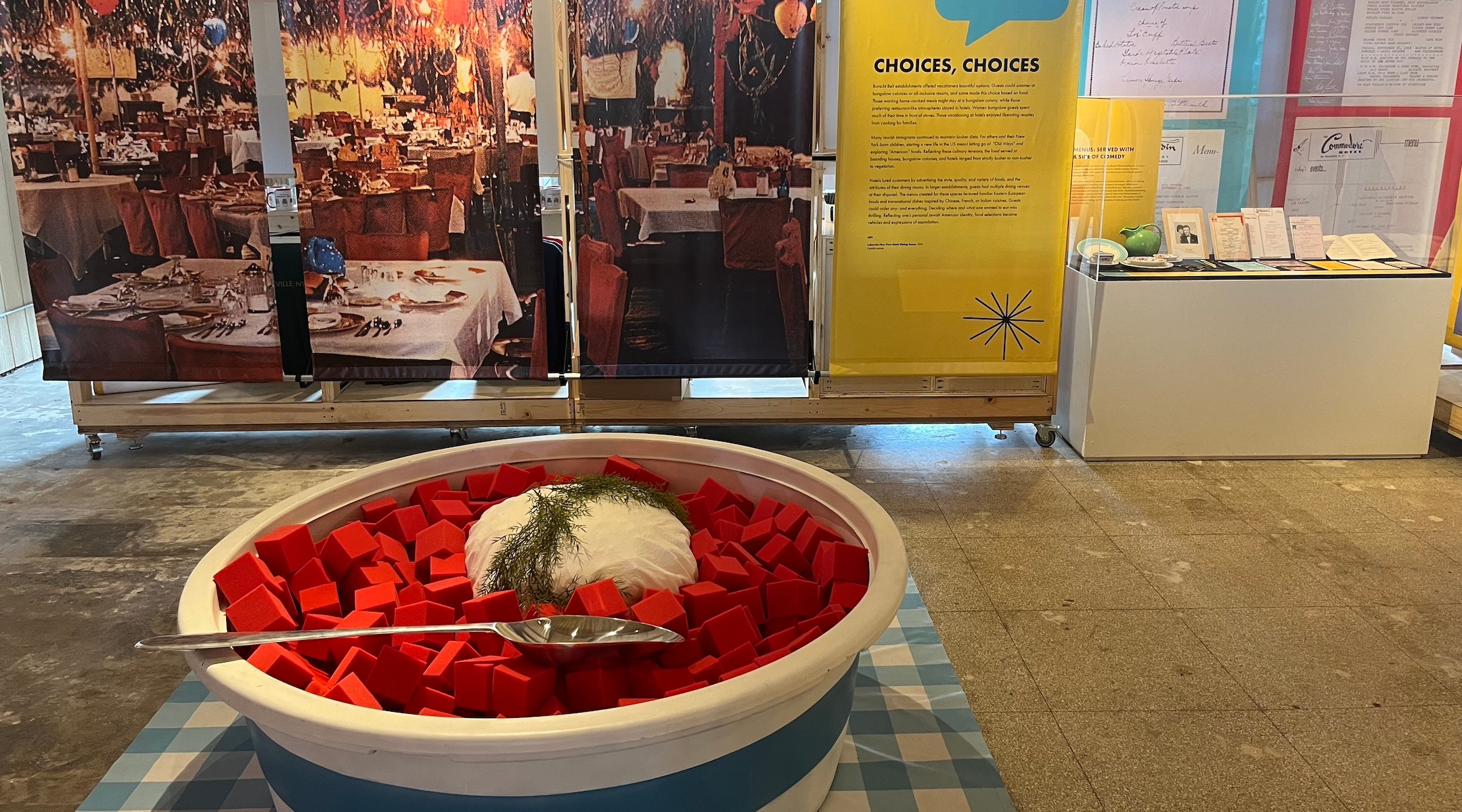
A large sculpture of a bowl of borscht by the artist Robin Schwartzman is the centerpiece of “And Such Small Portions! Food and Comedy in the Catskills Resort Era” exhibit at the Borscht Belt Museum in Ellenville, N.Y. (Courtesy Borscht Belt Museum)
And as the old saying goes, tragedy plus time equals comedy. “So much of comedy is about discomfort or anger or frustration or anxiety,” Jaffe said. The exhibit includes a one-liner from Joan Rivers: “We all mourn in our own way. I mourn with a good steak.” It’s a joke about appetite, but also a variation on “living well is the best revenge.”
Bach, the curator of decorative arts at the New-York Historical Society, knows intimately about the connection between the Catskills, food and humor: Her grandparents owned and operated the Grand Hotel, a kosher resort in Parksville, New York.
“Everything that had to do with food at my grandparents’ place was infused with comedy in some way,” she recalled. “Usually it was just the sort of back and forth thing in terms of getting meals out. But it just was so much a part of the culture that even as a small child, I was very aware of it.”
Her grandparents insisted that “nobody should go away hungry,” she said. “They wanted it to be an atmosphere where people were happy and they were enjoying themselves, and that extended to the way that food was served. There was just a lot of humor that surrounded everything.”
That humor became as closely identified with “the mountains” as the food. A portrait of Danny Kaye is featured on a wall of “Legacies.” It recalls that the Jewish comic actor, like a slew of other comedians, started as a “tummler” in the Catskills — a combination emcee and social director whose job it was, according to Jaffe, to keep guests from heading home to the Bronx on rainy days.
The small exhibit, located in a part of the old bank building that the year-old museum hopes to turn into a full-sized repository of all things Borscht Belt, features various images and objects pairing the culinary and the comic. There’s a milk can invoking the Jewish farmers who would eventually convert their homes and barns into inns and boarding houses for Jews who wanted to escape the stifling city in the summer. There are grocery items that evoke the era: Savarin coffee, Breakstone cottage cheese. There’s even a bencher — a booklet containing the grace after meals — from the late, lamented Tamarack Lodge.
The bencher suggests the diversity of the mountains, which drew Jews from across the religious and ideological spectrum. Both curators noted that the third section of the exhibit is called “Choices, Choices,” referring not only to the variety of food, but to the diversity of the guests.
“I don’t know if there’s a comparable place where secular and religious, it doesn’t matter, could go and congregate,” Bach said. “That’s what separated the Catskills from being a member of a temple. You’re meeting a range of people who are Jewish, who may not be religious, but the cultural and the ethnic bond is there.”
The museum hopes to celebrate that bond next weekend with its second “Borscht Belt Fest,” a three-day event featuring comedy performances, lectures and tours of the museum. On opening night, Friday, July 26, a “Dine Like It’s 1968” dinner will feature food inspired by a 1968 menu from The Waldemere Hotel in Livingston Manor, New York.
Talking to the curators, I thought about other connections between Jewish food and Jewish comedy, especially in the mid-20th century. For the guests of Kutsher’s, the Concord, the Nevele and Grossinger’s, the mountains represented an escape from the city, but also an escape into their comfort zone. The Eastern European food, like the Yiddish-inflected jokes, was heimish, or familiar, and kosher, even at hotels where it technically wasn’t. You didn’t have to make accommodations for your gentile neighbors or clients, but could revel in the shmaltz and the shtick. At a time of institutional antisemitism, when even other Catskill hotels barred Jews, the Borscht Belt offered Jews a full belly and belly laughs, on their own unapologetic terms.
“It’s not quite the shtetl,” said Jaffe, “but you’re getting out of the neighborhood and meeting new people, and you’re doing it with a sense of freedom.”
“And not too far,” added Bach. “It was really only 90 minutes away from the city.”
“And Such Small Portions! Food and Comedy in the Catskills Resort Era” will be on exhibit through November 2024 at the Borscht Belt Museum, 90 Canal St. in Ellenville, N.Y. Museum hours: Thursday to Sunday, 12 p.m.-5 p.m.
Learn more about the Catskills in a four-part online course from My Jewish Learning, taught by Andrew Silow-Carroll: “Borscht Belt and Beyond: The Lasting Legacy of the Jewish Catskills,” Tuesdays at 6 p.m. ET, Aug. 20 – Sept. 10.
The New York Jewish Week brings you the stories behind the headlines, keeping you connected to Jewish life in New York. Help sustain the reporting you trust by donating today.

